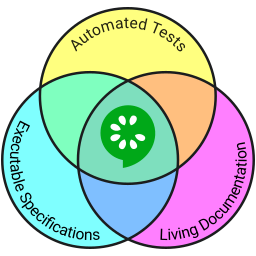Scenario: Breaker guesses a word
Given the Maker has chosen a word
When the Breaker makes a guess
Then the Maker is asked to score
.feature text files and are typically versioned in source control alongside the software.Given (/^ I am on www.google.com$/) do
Browser.goto “https://www.google.com.”
end – This will visit www.google.com@CucumberOptions(features="Features",glue={"StepDefinition"})cucumber-core-1.2.2.jar
cucumber-java-1.2.2.jar
cucumber-junit-1.2.2.jar
cucumber-jvm-deps-1.0.3.jar
cucumber-reporting-0.1.0.jar
gherkin-2.12.2.jarGiven” keyword is used to specify a precondition for the scenario.When” keyword is used to specify an operation to be performed.Then” keyword is used to specify the expected result of a performed action.And” keyword is used to join one or more statements together into a single statement.But” It denotes a logical OR relationship between two propositions. OR can be combined with the GIVEN, WHEN, and THEN statements.@RunWith and @CucumberOptions.
Adding_steps.rb
Multiplying_steps.rb>cucumber adding.feature --format HTML
>cucumber adding.feature --out report.html
>cucumber adding.feature --format pretty@” is the first character in a tag. Any relevant content after "@" can be used to define your tag.@InitialTest’@CucumberOptions has a dry run parameter that is used to configure the test parameters.| TDD | BDD |
|---|---|
| Test-Driven Development (TDD) is a method of developing software that is driven by tests. This means that the developers must first write the test cases before writing the code. | BDD is an acronym for behavior-driven development. It's a behavior-based development approach. |
| TDD tests are developed in a variety of programming languages, including Java,.NET, Python, Ruby, and others. | Given-When-Then steps are used to write BDD tests in a human-readable fashion. Non-technical people may read and comprehend these tests as well. |
| The scope is the key distinction between TDD and BDD. TDD is a development methodology. | BDD, on the other hand, is a collaborative methodology. |
| When a test fails because the specified function does not exist, TDD recommends writing the simplest code possible to pass the test, then reworking to remove duplication, and so on. | Creating an executable specification that fails because the feature isn't available, then writing the simplest code possible to make the spec pass in BDD. This process is repeated until a release candidate is ready to be delivered. |
| The test cases are written by the developers in TDD. | Users or testers write automated specifications in BDD, which are then wired to the code under test by developers. |
| Because TDD tests are written in specific programming languages, they are difficult to interpret by non-programmers. | Non-programmers can read BDD tests since they are written in a human-readable format. |
Package com.sample.TestRunner
importorg.junit.runner.RunWith;
importcucumber.api.CucumberOptions;
importcucumber.api.junit.Cucumber;
@RunWith(Cucumber.class)
@CucumberOptions(features="Features",glue={"StepDefinition"})
public class Runner
{
} @CucumberOptions. It contains two parameters feature and glue.import org.junit.runner.RunWith;
import cucumber.api.CucumberOptions;
import cucumber.api.junit.Cucumber;
@RunWith (Cucumber.class)
@CucumberOptions (
features = "src/test/java/features ",
glue = {"stepDefinitions"}
)
public class TestRunner {
} ​import org.junit.runner.RunWith for the @RunWith annotation and cucumber.api.CucumberOptions for the @CucumberOptions annotation.